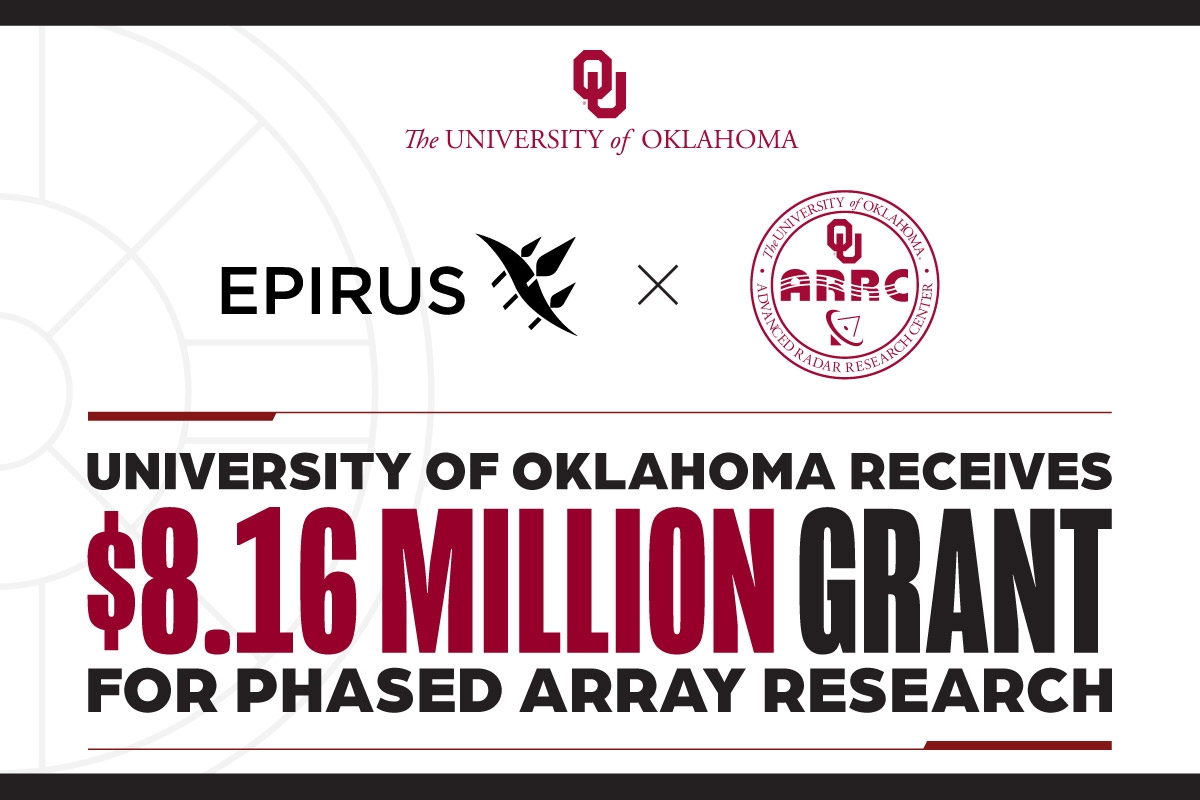The University of Oklahoma’s Advanced Radar Research Center, the largest academic radar program in the nation, and Epirus, a technology company developing software-defined high-power microwave systems, announced today an $8.16 million grant from the Office of Naval Research.
This collaborative, three-year endeavor is poised to dramatically enhance the field of phased arrays and enhance output power for all-digital, solid-state arrays. Researchers at OU’s ARRC, led by Mark Yeary, Ph.D., will serve as the principal investigators for the ONR-funded project. The research aims to determine the ability to increase the transmitted long-distance power density of phased arrays to overcome radar range limitations and counter the growing threat of unmanned aerial systems. This joint effort will, in turn, help enhance the use of directed energy systems for the U.S. Department of Defense’s counter-UAS mission.
This partnership builds upon the solid foundation established over the years between Epirus and OU’s ARRC and underscores their shared commitment to creating a worldwide center of excellence to push the boundaries of radio frequency (RF) technologies and advancing the development of critical technology capabilities. The grant was secured through the support of a Congressional addition to the fiscal year 2023 budget – and will support critical workforce development initiatives throughout Oklahoma, a growing hub for groundbreaking research and development.
“We are thrilled to continue to work with our OU partners to mature Epirus’ groundbreaking approach to digital twin technology and take the current state-of-the-art technology a step further,” said Dan Kultran, Chief Technology Officer, Epirus. “Our shared approach to innovative AI modeling and optimization of RF systems will drive development of novel technology solutions for DoD and other customer sets.”
The comprehensive scope of the project includes measuring and characterizing high-power amplifiers tailored for both radar and high-power microwave applications. The primary objective is to achieve unparalleled output power to extend the operational ranges of these crucial systems. The Epirus and OU research teams will leverage their combined expertise and work collaboratively to optimize both subsystem and system-level integration for these RF applications.
“The Advanced Radar Research Center at the University of Oklahoma has built a strong reputation in the research and development of digital phased array radars,” said Robert Palmer, Executive Director, OU ARRC. “This Department of Defense Office of Naval Research grant will lead to measurement systems located on OU’s campus that will greatly enhance the state’s capabilities to innovate and quickly respond to opportunities to advance military readiness and warfighting capabilities.”
By combining the expertise of a prestigious academic institution like OU’s ARRC with the innovative ethos and technological agility of Epirus, this project is poised to make significant strides in RF systems design. The outcomes of this research have the potential to deliver far-reaching implications, ensuring the U.S. government and technology industry have access to cutting-edge long-distance phased array solutions for a spectrum of applications.
The Oklahoma Congressional delegation expressed their support for Epirus and OU’s partnership:
“As we have seen prominently in Ukraine recently, the use of unmanned aerial systems continues to proliferate with deadly consequences. With tensions growing from adversaries around the globe, I applaud these two teams for working together on this critical issue. I am fully confident that the University of Oklahoma, a national leader in the research and development of radar technologies, Epirus, a national leader in the development of high-power microwave technologies to counter UAS and UAS swarm, and the Office of Naval Research will develop technologies to increase our ability to detect and defeat UAS threats,” commented Congressman Tom Cole.
“The University of Oklahoma is leading the way with public and private partnerships to create practical and innovative technologies to help protect our national security,” said Senator James Lankford. “This exciting partnership between OU and Epirus creates new ways to identify and counter the growing threat from drones through radar and high-power microwave technologies. Oklahomans know how important it is to be ready for what comes next. This partnership helps make sure we are ready to keep Americans safe as we face threats from around the world.”
Senator Markwayne Mullin added, “I am proud of all the work that is being done in Oklahoma to increase our capability to counter the growing threat posed by unmanned aerial systems. I have seen firsthand the advancements Oklahoma University and its Advanced Radar Research Center have made in the developing new radar technologies for commercial use as well as for use by our warfighters. The teaming with Epirus, who has become a key partner in Oklahoma at Fort Sill and the Fires Innovation & Science Accelerator (FISTA), brings two powerhouses together that will result in rapidly increasing our abilities to develop and field technologies to defeat the growing unmanned aerial system threat.”


